Climbing plants for the gazebo, requiring care
Professional gardeners decorate gazebos with plants that are quite demanding to care for. They are distinguished by stunning decorative properties and beautiful, abundant flowering.
But it is very difficult to grow and preserve such species, therefore, when choosing, you need to pay attention to the conditions of the environment in which they will grow, namely:
- Soil fertility;
- Average summer and winter temperatures;
- Illumination level;
- Drafts and wind direction.
Consider the most famous specimens from this group.
Climbing roses
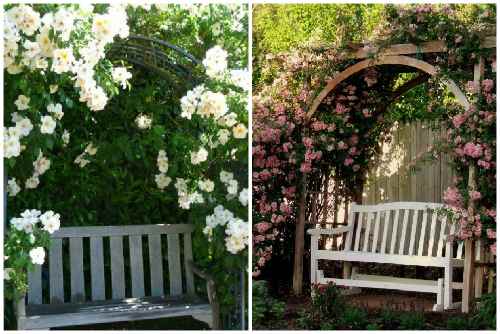
The whips grow up to 9 meters long. It is advisable to organize additional support for them, especially during flowering, when the buds that appear add weight to the green mass. A climbing rose can bloom once a year or please the eye with flowering all season - it depends on the specific species.
The plant requires abundant light throughout the day. Also, the landing site should be well ventilated. Excess moisture is detrimental to the roots, therefore, the close proximity of the groundwater to the soil will have a bad effect on the state of the plantations. The growing substrate must be fertile.
To provide proper care, you must regularly do the following:
- Loosening the soil;
- Fertilization;
- Pruning as you grow;
- Correct watering;
- Treatment for fungal diseases and parasites;
- Shelter from frost due to poor cold resistance.
Clematis
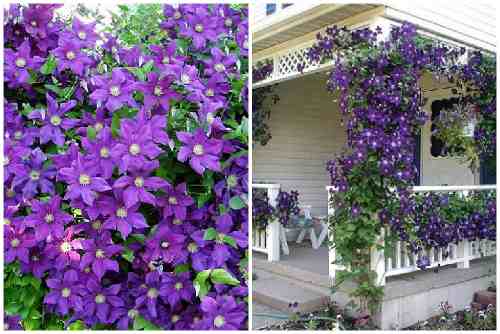
It is a climbing plant of the buttercup family and is perfect for decoration due to its abundant flowering. Such flowers for the gazebo will make it a true work of art. A young specimen, which has recently been planted, cannot stand the bright sun, so it is advisable to shade it. Clematis care includes:
- Fertilization;
- Constant weeding;
- Loosening the soil;
- Fastening the growing shoots to the support.
The "green inhabitant" does not like highly moistened soil, although it requires regular watering. It also needs to be protected from drafts, and before the winter period, make an easy shelter.
Decorative pumpkin
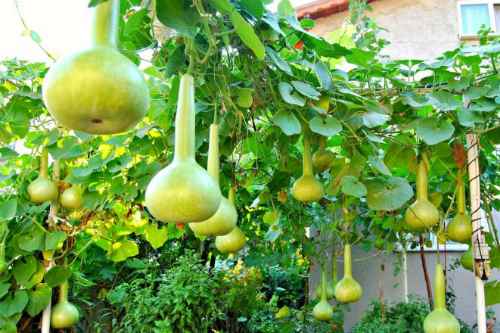
The decorative pumpkin has beautiful leaves and belongs to the fruit varieties of climbing plants, which can be used to attractively decorate the gazebo. Such a green space in the fall can give a good harvest. But also pumpkin fruits are inedible, but just decorative varieties.
Wisteria

Japan represents the homeland of wisteria, and such a "green pet" is valued for its flowering period, when hanging clusters of different shades (white, lilac, purple, pink) are formed on the vines. One such bunch can be up to 0.5 meters long. It will effectively decorate not only arched structures (to which it is most suitable), but also a gazebo. All varieties are unstable to winter cold, except for one - "Blue Moon" (Blue Moon). Blue clusters of such a vine can tolerate frost down to -30 degrees;
Honeysuckle and actinidia
They give fragrant and tasty fruits to the table, create a decorative wall from vines. In actinidia, the fruit tastes like kiwi. Honeysuckle berries, rich in vitamins, make preparations for the winter period in the form of jam, compote, jam, which looks like cherry in taste and color.
Akebia
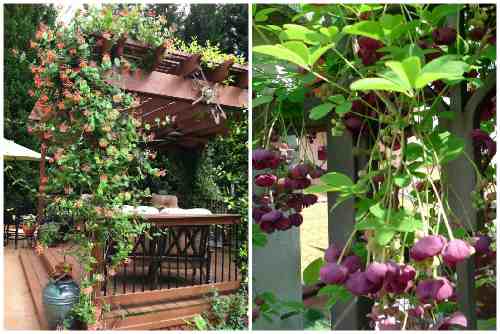
Akebia is a plant that has recently begun to spread throughout Russia. In its shape, the fruits of akebias are similar to mangoes, and in purple color they resemble plums. Such a liana blooms in May, bears fruit - from August to almost the end of October, has a sweet, tasty, sticky to the touch pulp. On sale, such a specimen is extremely rare; it is better to purchase its seedlings in large nurseries.
Perennial climbing plants - what to choose?
Today, many species of perennials are known that can be planted in the country. Here are some types of shrubs that can be planted near the gazebo:
- treelike and herbaceous.They differ from each other in that in the former, the plantings grow annually, and in the latter, the ground part dies off in the fall, and grows back in the spring;
- frost-resistant and thermophilic. Some can hibernate without additional shelter, while others need mulching or insulation of the ground part.
To decorate the gazebo, the following perennials are often planted:
Sea anemone kolominta. It is an ornamental fruit shrub with vine-like shoots, the length of which can reach up to 15 meters. The change in leaf color during the season looks especially impressive. The initial light green color changes to white, which turns into a yellow, pinkish, crimson hue. In addition, flowers spread a pleasant aroma around them. In the fall, berries appear, similar in taste to gooseberries, with a rich content of vitamin C.
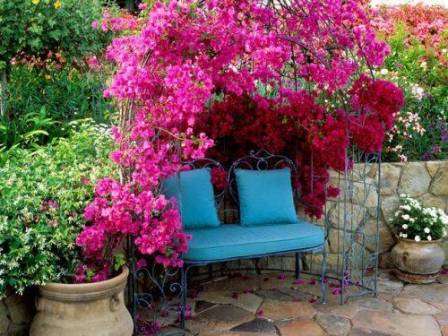
Vineyard is a liana crop that grows in North America and Asia. Only two out of twenty species are cultivated in Russia. Short-flowered (Ussuriysky) is widespread in the Primorsky Territory and the western regions of the country. Aconitol, cultivated in central Russia and southern regions. The decorative appearance of the plant is given by the contrast of leaves and berries. With the onset of summer, the berries stand out against the background of green leaves, and closer to autumn - the fruits acquire a bluish color, and the foliage is red. But the berries are not edible.
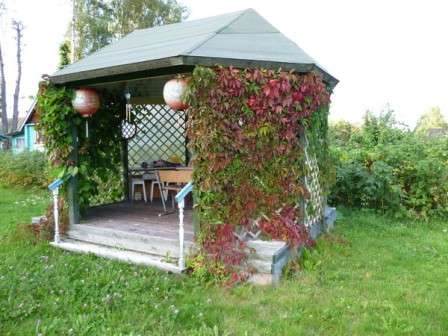
Honeysuckle is an unpretentious perennial, easily tolerates crown pruning and its formation. Over the summer it grows up to five meters. It blooms with fragrant flowers, which are an excellent honey plant. In some varieties, berries can be used in food.
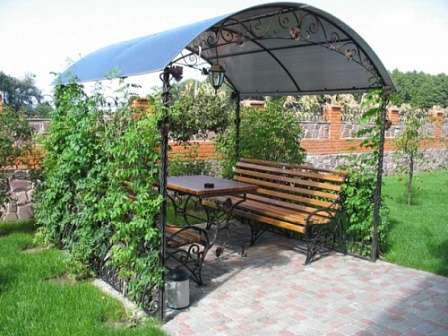
Clematis is a perennial flowering liana, with flowers of various shades. Clematis blooms for almost three months, and is very abundant. The plant looks most impressive if planted in a sunny area. For the original decoration of the gazebo, you can use various varieties of clematis that are in harmony in color.
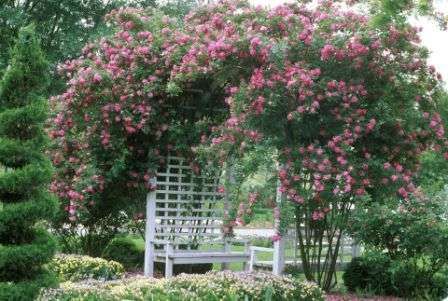
Climbing roses leave no one indifferent. Currently, they are actively used to decorate summer cottages. There are many varieties of roses. They differ in the shape and color of the buds, the timing of flowering. Their shoots can grow up to 15 meters in height. Curly roses with flexible shoots - ramblers are especially popular. They bloom magnificently and for a long time until late autumn, they are not afraid of frosts, some varieties have a rich aroma.
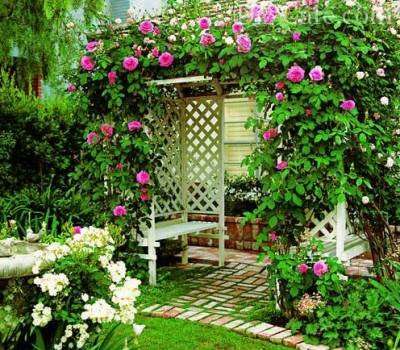
Wisteria is a beautiful plant that braids any structure or arch, perfect for decorating a summer cottage. Wisteria flowers have different colors - purple, yellow, white.
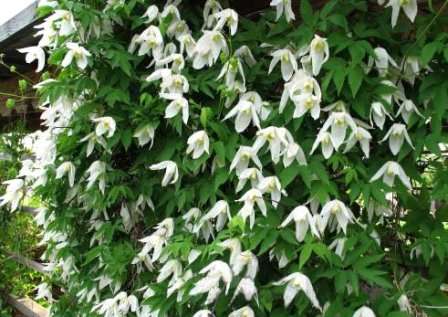
In addition to these plants, a wonderful decoration for the gazebo is an unpretentious green ivy, braiding any support, Chinese lemongrass with a citrus scent, and replacing summer green foliage with yellow-orange in autumn.
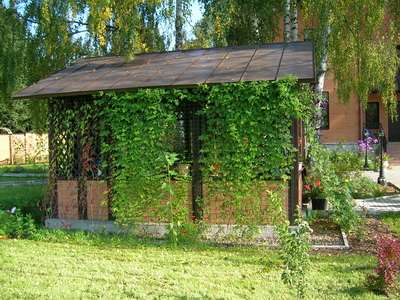
Climbing plants for a gazebo, perennials not only decorate the gazebo, but also help it to organically fit into the surrounding landscape, hide existing defects and unsightly places. In addition, braiding the gazebo, they create natural coolness and shade, protect from wind and rain drops. Also, for the cultivation of such plants, a large area is not required; many perennials are not demanding on the soil. The exception is clematis, climbing roses, which, on dry and poor soil, form a weak flowering.
A selection of different curly flowers
Curly perennials
Many flower growers call climbing roses the most favorite climbing plants. No vocabulary can adequately describe their tenderness and beauty. Climbing roses are divided into two varieties - those that bloom profusely once a year, and those that bloom twice a season. You can admire them endlessly.Huge color palette, undemanding care, easy reproduction makes them desirable decorations in any garden area.

Clematis. Delicate vines with huge lush flowers simply captivate the eyes of others. Clematis flowers bloom at the end of June and delight the surrounding world with their beauty until mid-September. They are single-colored or terry. The color palette is from white to dark purple. The plant loves watering, sunny and calm areas of the garden and regular fertilization.

Honeysuckle. An unpretentious climbing plant that feels good in semi-illuminated places. Fragrant, delicate inflorescences delight their owners with a variety of colors - pink, purple, red shades.

Ivy. And although many flower growers and summer residents prefer flowering climbing vines, evergreen ivy can compete with them. It grows at a slightly slower pace, but firmly braids all nearby vertical surfaces. Any place where ivy is planted will become a home for him, but only with the only condition - regular watering and supply of fertilizers. Surely a gazebo near the house, completely entwined with ivy, is the dream of many romantics and lovers.
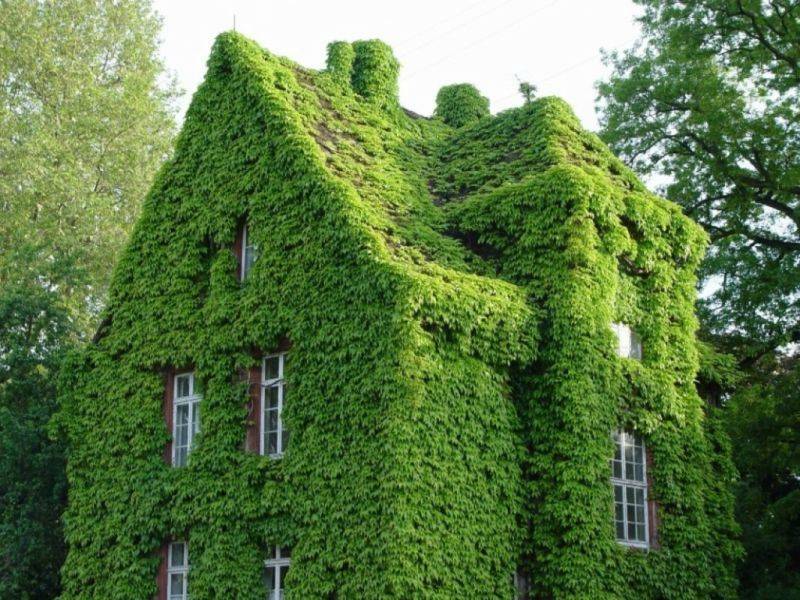
Girlish grapes. A versatile liana that is especially beautiful and picturesque in the autumn. A real find for decorating a garden plot at the end of September, when nature loses its freshness and bright colors. Thick lashes of grapes protect and braid all the necessary surfaces.
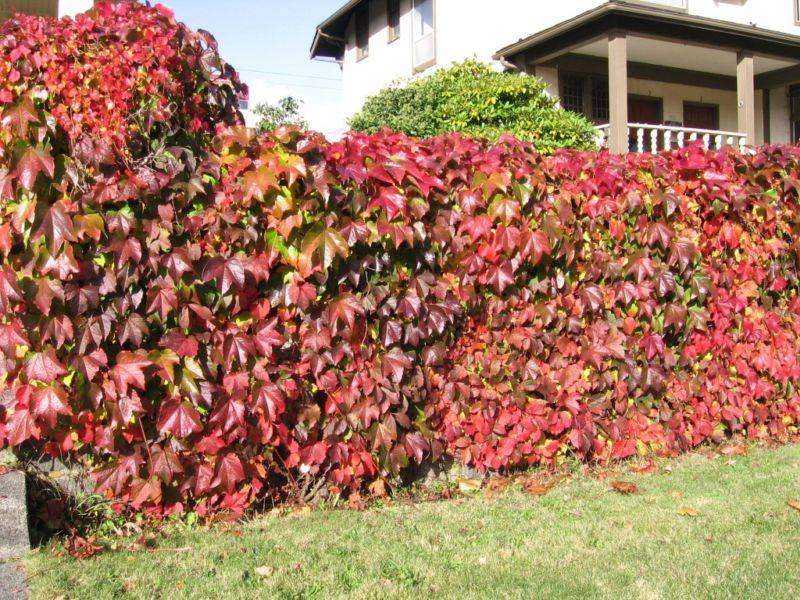
Wisteria, or wisteria
Recently, many new varieties of subtropical wisteria have been bred, which are able to withstand frosts down to –40 ° С. In particular, Wisteria macrostachya Blue Moon has such characteristics. Thanks to this, this charming climbing plant with delicate bluish-purple flowers can now be successfully grown in the middle lane.
From spring to late summer, wisteria should be watered regularly so that the soil is always slightly damp, but not too wet. And from mid-September, watering should be gradually reduced. To achieve spectacular flowering, during the growing season, the plant needs to be fed once a week: alternate mineral fertilizers (for example, Kemiru Lux) and organic (mullein infusion, diluted in a ratio of 1:20). And in order for the shoots to grow in the right place, beautifully braiding the gazebo, they must be constantly guided and tied up, and also shaped when pruning.
Winter hardy climbing plants
Climbing rose. The climbing queen of flowers, despite its external fragility and sophistication, endures frost. But you need to be prepared for the fact that a luxurious shrub requires special care. The neatly tied shoots will allow the plant to grow up to 5 meters in height.
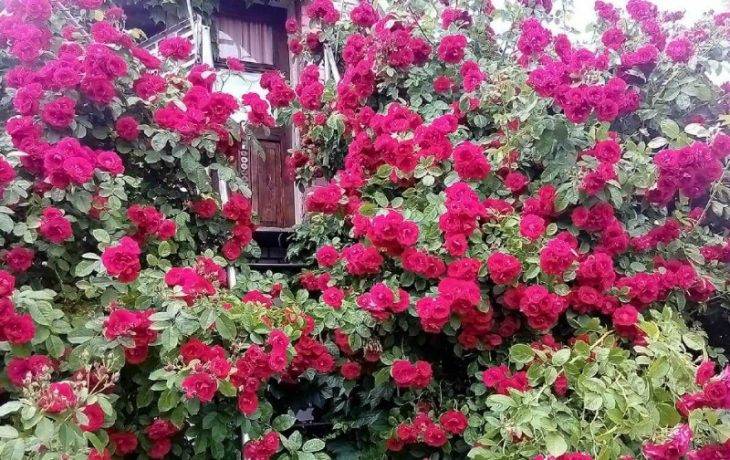
Euonymus. A plant with poisonous fruits, but the bright green color of large leaves looks very impressive. Needs shaping and regular pruning, frost can withstand up to -35 degrees. Euonymus prefers moisture and shady places.
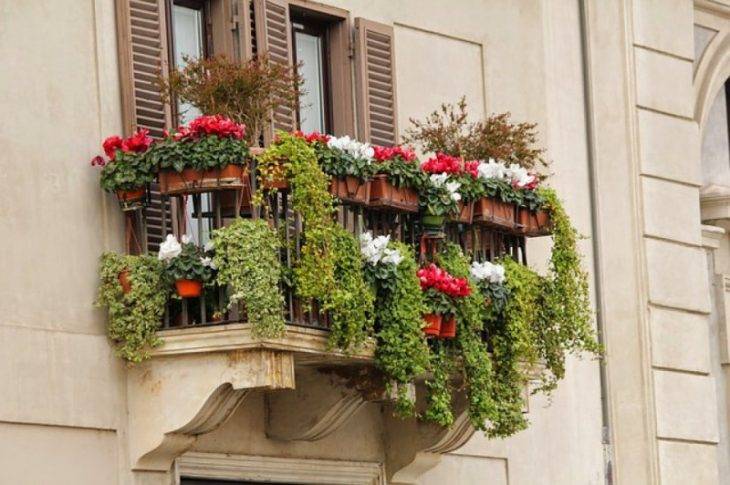
Campsis. Sprawling liana with orange oblong flowers without shelter can withstand frost down to -20 degrees. Kampsis grows equally fast both in the sun and in the shade, flowering begins in the third year after planting, its duration from mid-summer to the end of October.
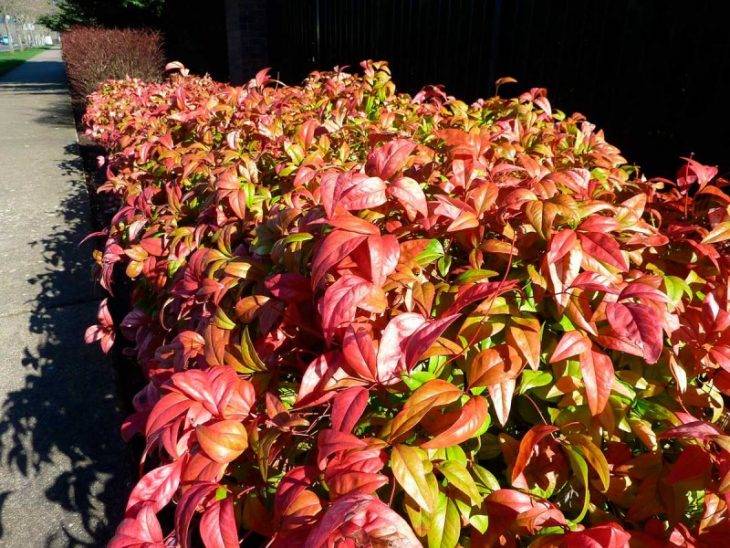
Lemongrass Chinese. By regularly feeding and watering the plant, which must be planted in the shade, you can grow it up to 15 meters high.

Does not require insulation, the phase of intensive growth begins from the second year of planting. You can perfectly shade the gazebo with lemongrass, its fruits exude an indescribable citrus aroma.
Natural fencing is the ideal eco-friendly solution for aesthetically pleasing gazebos, hedges or terraces.
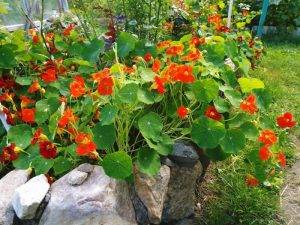
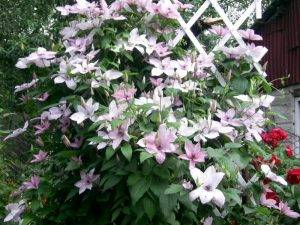


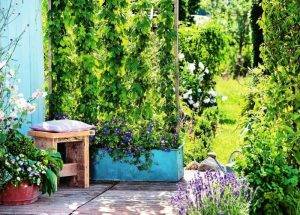
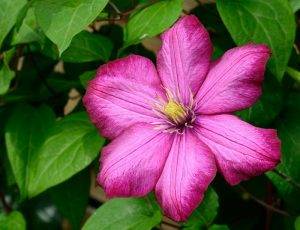
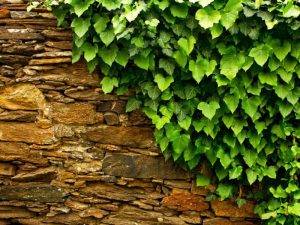
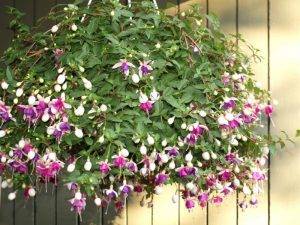
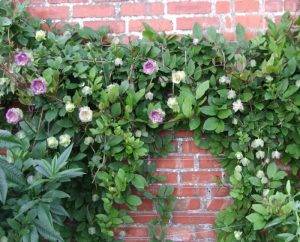
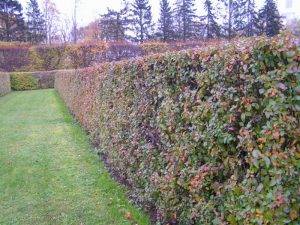
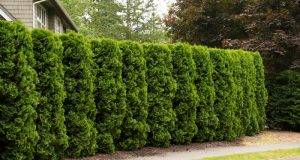
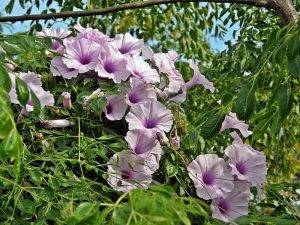
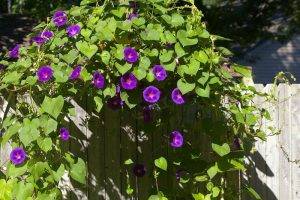
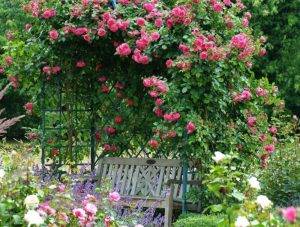
Even northern residents can afford to grow a luxurious hedge without worrying about how the right plant will survive the cold season. As for the inhabitants of regions with a milder climate, they can change plants every year or give preference to a one-year-old pet.
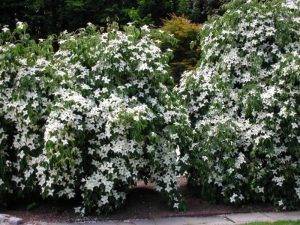
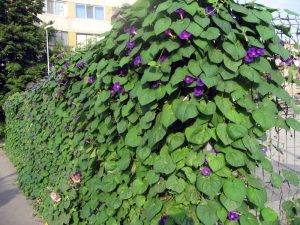
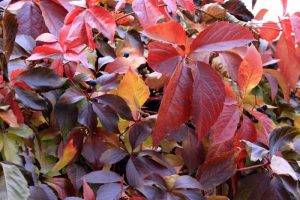
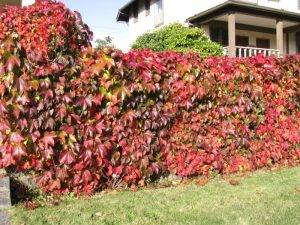
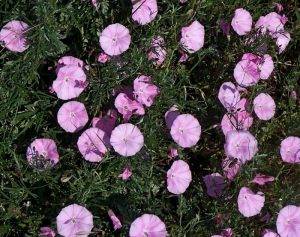
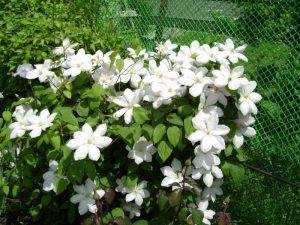
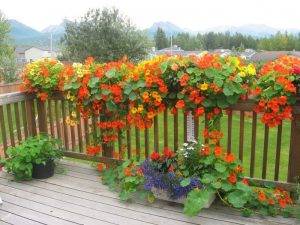
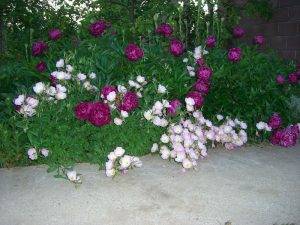

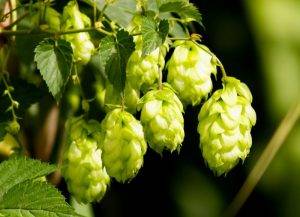
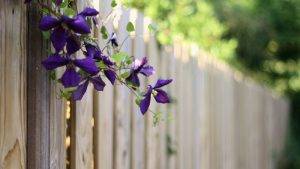
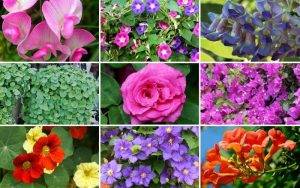

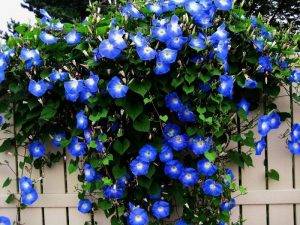
The most popular varieties according to reviews of summer residents
Ivy
It is not uncommon to see him on the walls of ancient castles and fortresses. Not surprising! A small seedling quickly grows into a powerful, evergreen vine. It spreads quickly, when decorating, it is necessary to control its growth. It braids well both horizontal and vertical surfaces due to the small air roots, which adhere firmly even to the stone. Not suitable for painted surfaces, because you can only remove the plant with a thick layer of paint. If the gazebo is located in the sunny part of the infield, it is the ivy that will provide continuous shade in it.
Another little known, but important property of ivy is its fire resistance. The plant is badly flammable
The close location of the barbecue will not do much harm to him.

Ivy.
Grape maiden five-leaf
Fast-growing climbing plants for decorating a gazebo are not uncommon, but maiden grapes are the champion among them. One plant reaches 20-30 meters in length. The variety is widespread throughout the world. The plant is frost-resistant, completely unpretentious in care. The gazebo, braided by it, will be beautiful from early summer to mid-autumn. In June, large bright green leaves appear, the flowering of grapes is unattractive, but does not spoil the overall picture. For many summer residents, it is during the golden autumn that the Maiden Grape acquires its aesthetic value. The color palette of foliage varies from light yellow in the shade to bright red, even crimson in the sun. The dark blue, almost black fruits will ripen by early September. By combining on your site the woodworm, which takes on a delicate golden color in autumn, and girlish grapes, you will create a beautiful area for photo and video shooting from climbing plants and your gazebo. Guests and family will be very grateful to you for this!

The grape is maiden five-leafed.
Common hops
For lovers of homemade bread and beer producers, ordinary hops are ideal! For decorating a gazebo, it is beautiful and useful, because the plant is also medicinal. In Russia, it is widespread, the only exception is the Far North and Altai. The hop's root system is strong, grows quickly and reaches 7 meters. For planting, it is better to choose partial shade, although it feels comfortable in the sun and grows very densely. Prefers clay soil, fertilized with humus.
Hops look neat and beautiful during the flowering period. Its light green cones are grouped side by side and stand out with bright strokes against the background of green leaves. As they ripen and dry, they acquire a pleasant golden color.

Common hops.
Morning glory blue
Among the popular annual climbing plants for the gazebo is the name "morning glory". Most famous is the blue morning glory. It independently finds support and begins to twine around it with powerful shoots. Plants can spread over an area of about five square meters, which is enough to decorate one wall of a small gazebo. Propagated by seeds that fall out of the pods and will give young shoots the next year. Conditionally, Ipomoea can be called a perennial plant, since once planted in a certain place, it will continue to grow from seeds for many years.
In the cool morning hours, gramophone flowers of a delicate blue color (up to 10 cm in diameter) open. Closer to lunchtime, the flower closes - it does not like direct sunlight. If in the sky clouds of morning glory pleases bloom all day.

Morning glory blue.
Campsis or tekoma
A perennial vine, without which it is difficult to imagine at least one summer cottage. The gazebo, in the composition of which the tekoma is involved, stands out against the background of the greenery of the garden with bright orange flowers up to 8 cm in diameter, similar to decorative bells collected in inflorescences. Often these flowers attract little princesses, and they are happy to make ball gowns for their flower dolls. There are two types of this beautiful plant: large-flowered and rooting. Both are frost-resistant owners of a strong root system (when the upper part freezes out, this vine will recover quickly enough). It easily tolerates short-term frosts up to 18 ° C. For the winter, the vines should be removed from the supports, laid on the ground and sprinkled.

Campsis or tekoma.
Schisandra chinensis
A plant for decorating a gazebo and delicious, healthy tea. Frost-resistant lemongrass is unpretentious in lighting, it is better to plant it in shaded places. In the first two years after sowing, the seeds grow slowly, then quickly grows, turns into a wonderful climbing plant with beautiful green foliage. During the flowering period, lemongrass exudes a delicate aroma. In autumn, lemongrass will delight you with bright red fruits!

Lemongrass Chinese.
Annuals
In addition to perennial climbing plants on the gazebo, you can plant even annual, but very original plants that are unlikely to decorate someone's gazebo in the vicinity.
Despite the additional care, you will receive a unique and beautiful landscaping, for which you can spend additional energy and time in the country.

Sweet pea
Curly annual with a characteristic strong and tasty odor. He loves warmth and the sun, so it is ideal for decorating a gazebo. Optimal growing conditions are neutral soil with humus, moderate amount of water and warm weather.
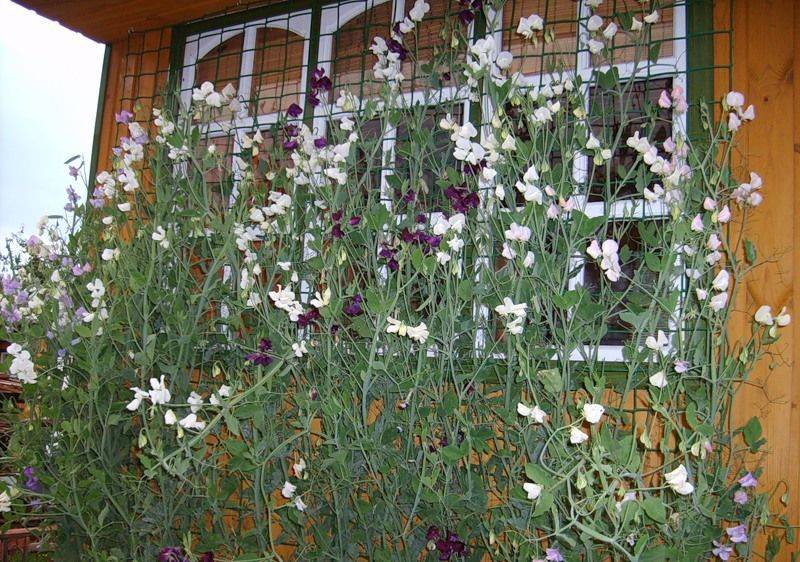
Morning glory (kvamoklit)
Morning glory is a bindweed plant that has more than a thousand species of both perennial and annual plants. Due to its beauty, morning glory is used in landscaping and decorating gazebos.
Since there are so many species, you will need to consult with the seller to find the best option for your climatic conditions.

Kobei
An interesting option for horizontal cultivation. Initially, the kobea is a perennial fast-growing plant, but it is customary for us to plant it as an annual. A semi-shrub vine will perfectly decorate your building, but only for one season.

Ornamental beans
Some varieties can even be eaten other than purple ones. Quite a popular annual plant for planting, which does not require any serious grooming, as well as temperature conditions.
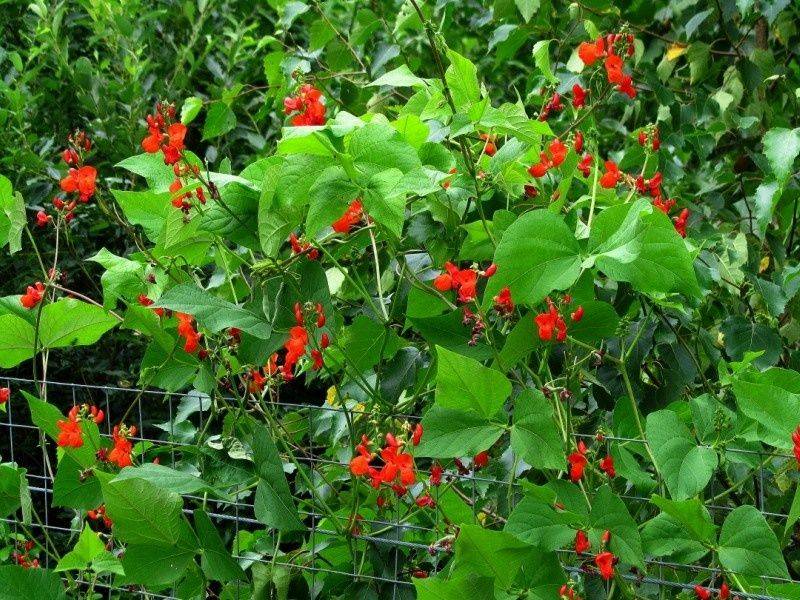
Curly flowers for the gazebo: climbing roses
You can not ignore the beautiful flowers, climbing roses, which are suitable for vertical gardening of any summer building, will help create a wonderful, "magical" world in your garden. With good summer care, roses can give shoots growth of up to 2.5-3 m
For once-flowering varieties of climbing roses, 3-5 annual and the same number of biennial shoots are left on the bush
With good summer care, roses can give an increase in shoots of up to 2.5-3 m. For once-flowering varieties of climbing roses, 3-5 one-year and the same number of two-year shoots are left on the bush.
Climbing roses during flowering are very beautiful, in real climbing or climbing roses, the height of the bushes can reach 5 m, the flowers are very small - up to 2.5 cm, double, semi-double or simple, of various colors, but there are a lot of them, the bush is literally strewn with them. Such roses bloom for a long time - up to 30-35 days, they are photophilous and thermophilic. They should be planted on the sunny, southern side of the gazebo or support, and covered with spruce branches for the winter. There are modern varieties of climbing roses with larger flowers up to 4 cm in diameter.
The flowers of climbing roses are formed on last year's shoots, therefore, overwintered bushes in the spring open, cut off the frozen and podoprevny shoots, spread shoots on the surface of the earth so that new ones grow from the middle of the bush. When they reach a length of about 70 cm, all the shoots are lifted and tied to a support. During the season, the bush should be fed 3-4 times with organic fertilizers with the addition of superphosphate or complex mineral fertilizers.
If climbing roses are re-flowering, then their flower buds are formed within 3 years, therefore, after the fourth year, the main shoots are completely cut out. In multi-flowering varieties, it is enough to have 1-3 annual shoots and 3-7 main shoots on which flowers are formed.
Most varieties of climbing roses reproduce well by cuttings. Of course, roses require care and attention, but if you decorate a gazebo, pergola or just a trellis wall with climbing roses, you will put the beauty itself in your garden for many years.
Recommendations
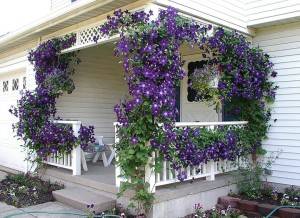
Clematis on the terrace
If the choice has not yet been made, then you can consider the list of the most popular climbing plants for landscaping the gazebo structure, these include:
- All grape varieties;
- Clematis;
- Honeysuckle;
- Ivy;
- Hop;
- Curly roses;
- Hydrangea.
Before dwelling on this or that type of living gardening, you should consider whether the gazebo will be completely in foliage or partially decorated with one or another type of vine. It often happens that gazebos completely covered with greenery look rough and not well-groomed.
It will be useful to study a certain variety and methods of its cultivation. If you plan to plant greenery with two or three types of vines, you need to think over their location so that they do not interfere with the active growth of each other.
Consider the benefits of several popular plants:
- The grapes are maiden. Completely uncaptious look. It grows very quickly. In the first year, after planting, it needs abundant watering, but the next year you can forget about caring for it. Feels good in an open sunny area, but the lack of light does not scare him. It has no requirements for the composition of the soil. The grapes grow in the form of a vertical continuous covering, which, with the onset of cold weather, will delight with a reddish color.
- Ivy. One of the most popular gazebo landscaping plants. An absolutely unpretentious look and can grow well both in the scorching sun and on the shady side. Only needs watering in very hot weather. Ivy is a perennial species and can delight with dense greenery for more than a dozen years.
- Honeysuckle. The view is a little moody. Gardeners love it for its lush flowering on summer days and bright berries with the onset of cold weather. For the normal life of the plant, it must be regularly watered and fertilized.
- Clematis. The most original vine, but requiring constant care. The plant has the ability to grow 2 or more meters and is ideal for decorative decoration of any gazebo. It grows relatively quickly. It is appreciated for the ability to combine several varieties with flowers of all kinds of shades.
Top climbing plants for home decor
Curly roses
Climbing roses are the real queens among the fast climbing plants for the gazebo. Lush flowers adorn the garden all summer long. There are many re-flowering modern varieties. Roses love warmth and lots of light. Place the gazebo directly under the sun and then the blooming garden will become your source of inspiration!
The curly rose pleases gardeners with its unpretentiousness. Good watering and fertilization is the whole secret of plant care. One of the most popular types is New Dawn. It quickly grows throughout the gazebo and pleases the owners with pale pink flowers. The variety is winter-hardy, but it is better to cover the flowers in frosts. New Down grows evenly in width and height, creating a unique atmosphere in the garden.

Curly roses.
Wisteria
A flowering tree has a dense trunk, but this does not prevent it from decorating, for example, the roof over the porch of a house. The plant blooms profusely and is not capricious in its care.Wisteria needs frequent watering only in the first year, and later in extreme heat. Experienced gardeners recommend mulching the plant and occasionally adding compost.
Among the climbing plants for the gazebo, Wisteria can be called fast-growing and perennial, but not winter-hardy. If the plant survives the frost during the first wintering, it will give new shoots in the spring.
Wisteria (another name) grows, twisting, but this must be strictly monitored. The plant looks much more beautiful if you let it spread the shoots to the sides. To do this, you need to direct them in the right direction in time. If this is not done, Wisteria can suffocate itself or damage home decor. When properly cared for, wood creates a unique atmosphere.

Wisteria.
Clematis
Climbing plants for a gazebo are often chosen for a photo. Their best names are searched all over the internet. In the top searches of search engines, Clematis (Buttercup family) is always found.
A fast-growing vine can grow up to 3 meters, so it needs strong support. The plant has no petals, only individual cups of 4-7 leaves, painted in different colors. Clematis stands out against the background of curly ones in that they give an unprecedented number of shoots. The more there are, the more abundant the flowering will be. With the right deep planting, the plant grows more and more every year and gives a lush bloom, creating a real flower paradise in the garden!

Clematis.
Akebia
The plant is often referred to as a chocolate vine. In the East, it can grow up to 12 meters, but in our harsh climate, Akebia grows smaller in size. In total, there are 2 types of Akebia: five and threefold. It is quite simple to distinguish them: the first leaves on the handle are indeed located in the form of fives at the same distance from each other. Akebia trifoliate grows up to 25 meters and in autumn pleases with fruits of blue lavender color.
The plant was nicknamed the chocolate liana for its spicy aroma reminiscent of sweetness. This is not its only advantage. An unpretentious plant to care for requires composting at the initial stage.

Prince
The plant is suitable for those gardeners who want to make a gazebo from climbing plants with their own hands .. Here you definitely do not need the advice of experienced gardeners, because Knyazhik is one of the most unpretentious vines to care for. In country houses, it is often planted to close an unsightly wall or create a "hedge".
Prince.
Curly Knyazhik is loved in Russia for its excellent winter hardiness. Its flowering can be seen only on the shoots of the last year and it comes in May-June. Knyazhik's flowers are simple and terry of any shades: white, blue, pink, etc. Many consider the plant to be graceful and call it a "gardener's classic". When planting a plant, you can not be afraid of low temperatures. Your efforts will definitely pay off with perennial flowering!
Rules for planting climbing green plants at a pergola
Various types and varieties of decorative vines can be used as climbing vegetation for pergolas. But by planting them next to structures, many make unforgivable mistakes that could have been avoided. What can not be done with vertical gardening of a small architectural form?
- First of all, you should not plant climbing vegetation with different periods of growth and development near the pergola. Such a difference will not allow you to create a beautiful hedge.
- You should not choose a large number of types of vines for landscaping the structure. Excessive variety can make it much more difficult to care for them. At the same time, the pergola will look colorful and stand out from the general design concept of the garden plot.
- You cannot neglect the resistance of plants that will twist your pergola or gazebo to the climatic conditions of your strip.Some varieties in severe years may lose their attractiveness as a result of freezing.
Given these errors, the following landing rules can be concluded:
- Choose no more than 2 ... 3 types of plants for the pergola. It is best if these are vines of one or two types.
- Pick plants with similar development and growth times.
- Plant only varieties and species of climbing vines that are adapted and resistant to your climatic conditions.
